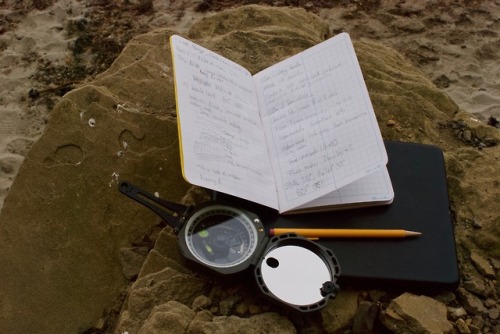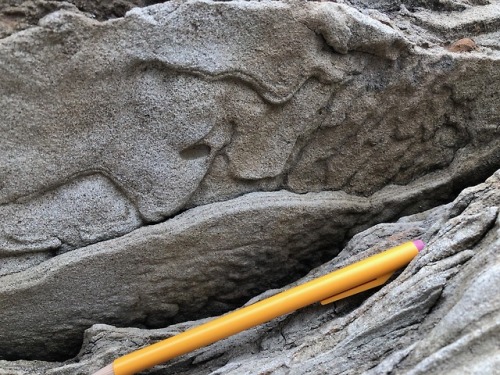adventurous-watermelon: Working in the field is a wonderful experience. On the central Oregon Coast,
adventurous-watermelon: Working in the field is a wonderful experience. On the central Oregon Coast, the vast sequence of sedimentary rocks provides a wonderful training ground for geologists. Present on this one outcrop on the beach in North Cove at Cape Arago are many of the common sedimentary structures. Pictured top to bottom are: flame structures, flute casts, and convolute bedding.Flame structures are a form of soft sediment deformation, which is disturbance in the nice flat beds of sandstone due to the compaction from the weight of overlying material. These sandstones were deposited in a shallow marine area, just offshore of the ancient Oregon coast, and contained a lot of water as a result. The weight of sand and mud deposited in the future caused these old sands to release their water, disturbing the neat layers and laminations of this rock. In the case of flame structures, small points of sediment are forced into overlying beds. These can indicate the ancient flow direction of whatever water deposited the sediment, which is useful for reconstructing the geologic history of a site.Flute casts are not musical, and are related to the way streams move sediment. Shallow water moves sediment in interesting ways, but if you ever look into a shallow stream on a beach, you’ll see scooped-out holes in the bed of the stream. These result from scour and other sediment movement behaviors causing pits. Later sand was deposited on top of these flutes, filling them up and solidifying, preserving a cast of the ancient stream bed.Convolute bedding is another form of sediment deformation. These are a type of fluid escape structure, which form in a similar way to flame structures. When water is forced out of the rock be overlying material, the water moves sand grains and sediment around, causing the beds to realign in these odd shapes. All of these sediment structures go toward reconstructing the history of this part of Oregon, and the scenery that surrounds them adds to the mystique of the tales the rocks have to tell. -- source link
Tumblr Blog : adventurous-watermelon.tumblr.com



